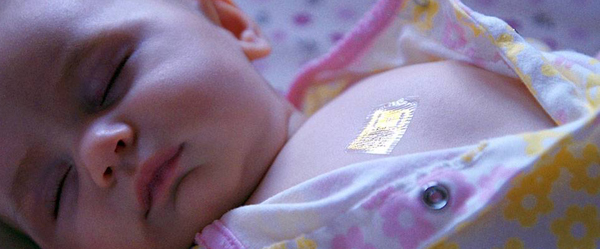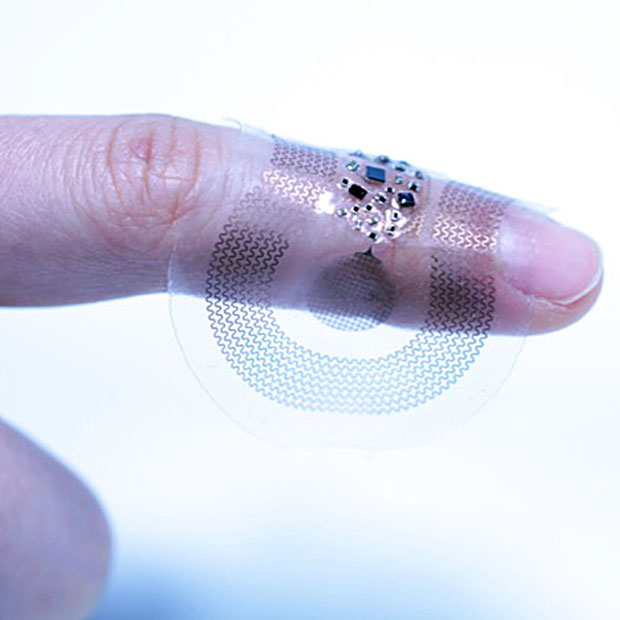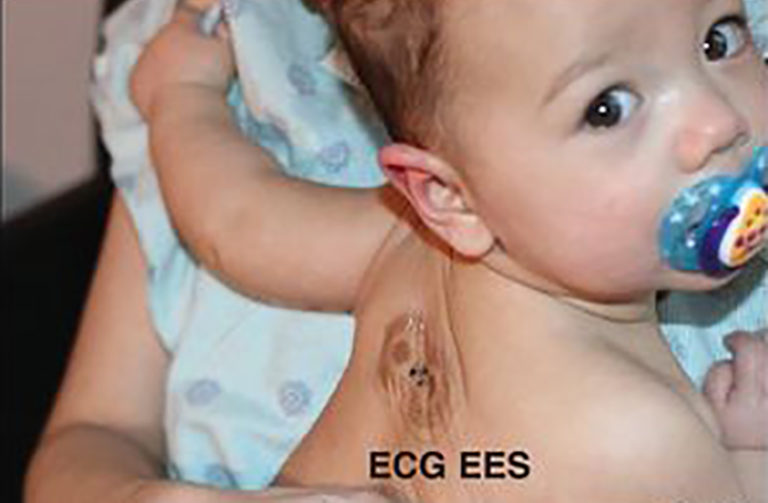Battery-free wearable patch can help monitor health
A battery-free electronic patch that sticks onto skin like a temporary tattoo can be powered wirelessly by smartphones to help monitor health, researchers say.

Wearable sensors capable of monitoring human vital signs. MC10 photo
By Charles Q. Choi, IEEE Spectrum 03 August 2016
A variety of wearable technology is on the market to monitor life signs, but these mostly possess hard components that have to be strapped onto the body. Scientists have been developing stretchable electronics that can fit better onto people, but these were limited by the size and weight of their batteries.
Now researchers have developed a stretchable, wearable ultra-thin device that can not only wireless transmit health data, but also is wirelessly powered via near-field communication transmissions. Smartphones, tablets and other consumer electronics use near-field communications with the Apple Pay and Android Pay wireless payment schemes.

| Flexible electronics that conform well to the skin allow for gentler adhesives, which are safer for delicate newborn skin. John A. Rogers, Northwestern University |
The battery-free nature of this patch makes it five to 10 times thinner than comparable gadgets, says study leader John Rogers, a materials scientist at the University of Illinois at Urbana-Champaign.
“It is quite easy to build soft, skin-mountable devices that can capture significant amounts of power wirelessly from external sources,” Rogers says.
Once wirelessly powered, the device’s LEDs illuminate the skin. Some of the light is absorbed, while the reflected light gets picked up by the patch’s light sensors. The device then wirelessly transmits data to an external device. An ultraviolet-sensitive material embedded in the patch can also measure ultraviolet ray exposure, and an embedded heat sensor can help measure skin temperature.
In experiments with a small group of volunteers, the scientists found they could use the device to monitor heart rate, blood oxygen level, skin temperature, ultraviolet radiation exposure, and changes in skin color. Heart rate, blood oxygen level, and skin temperature are well-known signs of fitness; ultraviolet radiation exposure can indicate risk of sunburn, while skin color changes are useful for detecting diseases such as jaundice.
“We believe that these systems represent the next generation of wearable technology, where thin, skin-like devices can interface with the body to provide clinically relevant data on health status,” Rogers says.
The range at which these devices can be powered by a smartphone “is a couple of centimeters,” Rogers says. “With long-range readers, the range is up to about 1 meter. When mounted under a mattress, such a system could provide coverage across a hospital bed, for instance.”

No wires, more cuddles. Northwestern wireless NICU monitoring system. Science, Creative Commons
The scientists are now testing these devices on hospital patients in sleep studies. They are also building a much broader array of sensors into these platforms, Rogers says.
The scientists detailed their findings online August 3 in the journal Science Advances.
Source IEEE Spectrum
| Sensors are first to monitor babies in the NICU. An interdisciplinary Northwestern University team has developed a pair of soft, flexible wireless body sensors that replace the tangle of wire-based sensors that currently monitor premature babies in hospitals’ neonatal intensive care units (NICU) and pose a barrier to parent-baby cuddling and physical bonding. |
| The team recently completed a series of first human studies on premature babies at Prentice Women’s Hospital and Ann & Robert H. Lurie Children’s Hospital of Chicago. The researchers concluded that the wireless sensors provided data as precise and accurate as that from traditional monitoring systems. The wireless patches also are gentler on a newborn’s fragile skin and allow for more skin-to-skin contact with the parent. Existing sensors must be attached with adhesives that can scar and blister premature infants’ skin. Northwestern University. Youtube Feb 28, 2019 |
| References |
Battery-free, stretchable optoelectronic systems for wireless optical characterization of the skin, Kim J, Salvatore GA, Araki H, Chiarelli AM, Xie Z, Banks A, Sheng X, Liu Y, Lee JW, Jang KI, Heo SY, Cho K, Luo H, Zimmerman B, Kim J, Yan L, Feng X, Xu S, Fabiani M, Gratton G, Huang Y, Paik U, Rogers JA. Sci Adv. 2016 Aug 3;2(8):e1600418. doi: 10.1126/sciadv.1600418. eCollection 2016 Aug.
Binodal, wireless epidermal electronic systems with in-sensor analytics for neonatal intensive care, Chung HU, Kim BH, Lee JY, Lee J, Xie Z, Ibler EM, Lee K, Banks A, Jeong JY, Kim J, Ogle C, Grande D, Yu Y, Jang H, Assem P, Ryu D, Kwak JW, Namkoong M, Park JB, Lee Y, Kim DH, Ryu A, Jeong J, You K, Ji B, Liu Z, Huo Q, Feng X, Deng Y, Xu Y, Jang KI, Kim J, Zhang Y, Ghaffari R, Rand CM, Schau M, Hamvas A, Weese-Mayer DE, Huang Y, Lee SM, Lee CH, Shanbhag NR, Paller AS, Xu S, Rogers JA. Science. 2019 Mar 1;363(6430). pii: eaau0780. doi: 10.1126/science.aau0780.
Improving care of critically ill newborns, Guinsburg R. Science. 2019 Mar 1;363(6430):924-925. doi: 10.1126/science.aaw2085. No abstract available.
Also see
No wires, more cuddles Northwestern Now
Wireless Skin Sensors for Newborns Will Let Parents Cuddle Fragile Babies IEEE Spectrum
A Temporary Tattoo That Senses Through Your Skin IEEE Spectrum
Stretchable and conformal electronics for peace of mind EDN Network
Flexible wearable sensor for detecting alcohol level can be worn on the arm UC San Diego News Center
